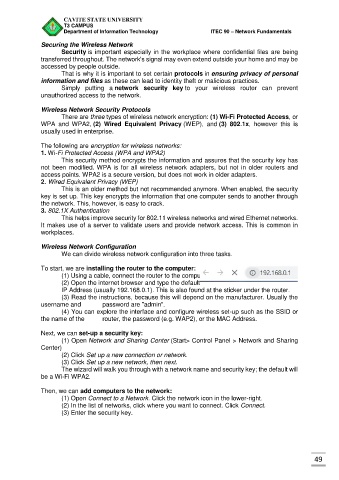Page 534 - PowerPoint Presentation
P. 534
CAVITE STATE UNIVERSITY
T3 CAMPUS
Department of Information Technology ITEC 90 – Network Fundamentals
Securing the Wireless Network
Security is important especially in the workplace where confidential files are being
transferred throughout. The network's signal may even extend outside your home and may be
accessed by people outside.
That is why it is important to set certain protocols in ensuring privacy of personal
information and files as these can lead to identity theft or malicious practices.
Simply putting a network security key to your wireless router can prevent
unauthorized access to the network.
Wireless Network Security Protocols
There are three types of wireless network encryption: (1) Wi-Fi Protected Access, or
WPA and WPA2, (2) Wired Equivalent Privacy (WEP), and (3) 802.1x, however this is
usually used in enterprise.
The following are encryption for wireless networks:
1. Wi-Fi Protected Access (WPA and WPA2)
This security method encrypts the information and assures that the security key has
not been modified. WPA is for all wireless network adapters, but not in older routers and
access points. WPA2 is a secure version, but does not work in older adapters.
2. Wired Equivalent Privacy (WEP)
This is an older method but not recommended anymore. When enabled, the security
key is set up. This key encrypts the information that one computer sends to another through
the network. This, however, is easy to crack.
3. 802.1X Authentication
This helps improve security for 802.11 wireless networks and wired Ethernet networks.
It makes use of a server to validate users and provide network access. This is common in
workplaces.
Wireless Network Configuration
We can divide wireless network configuration into three tasks.
To start, we are installing the router to the computer:
(1) Using a cable, connect the router to the computer
(2) Open the internet browser and type the default
IP Address (usually 192.168.0.1). This is also found at the sticker under the router.
(3) Read the instructions, because this will depend on the manufacturer. Usually the
username and password are "admin".
(4) You can explore the interface and configure wireless set-up such as the SSID or
the name of the router, the password (e.g. WAP2), or the MAC Address.
Next, we can set-up a security key:
(1) Open Network and Sharing Center (Start> Control Panel > Network and Sharing
Center)
(2) Click Set up a new connection or network.
(3) Click Set up a new network, then next.
The wizard will walk you through with a network name and security key; the default will
be a Wi-Fi WPA2.
Then, we can add computers to the network:
(1) Open Connect to a Network. Click the network icon in the lower-right.
(2) In the list of networks, click where you want to connect. Click Connect.
(3) Enter the security key.
49

